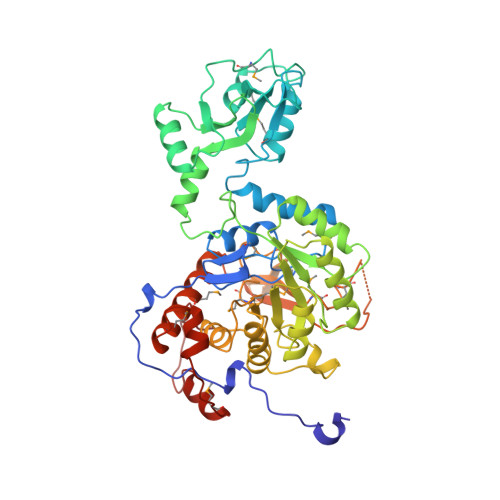Characteristics and crystal structure of bacterial inosine-5'-monophosphate dehydrogenase.
Zhang, R., Evans, G., Rotella, F.J., Westbrook, E.M., Beno, D., Huberman, E., Joachimiak, A., Collart, F.R.(1999) Biochemistry 38: 4691-4700
- PubMed: 10200156
- DOI: https://doi.org/10.1021/bi982858v
- Primary Citation of Related Structures:
1ZFJ - PubMed Abstract:
IMP dehydrogenase (IMPDH) is an essential enzyme that catalyzes the first step unique to GTP synthesis. To provide a basis for the evaluation of IMPDH inhibitors as antimicrobial agents, we have expressed and characterized IMPDH from the pathogenic bacterium Streptococcus pyogenes. Our results show that the biochemical and kinetic characteristics of S. pyogenes IMPDH are similar to other bacterial IMPDH enzymes. However, the lack of sensitivity to mycophenolic acid and the Km for NAD (1180 microM) exemplify some of the differences between the bacterial and mammalian IMPDH enzymes, making it an attractive target for antimicrobial agents. To evaluate the basis for these differences, we determined the crystal structure of the bacterial enzyme at 1.9 A with substrate bound in the catalytic site. The structure was determined using selenomethionine-substituted protein and multiwavelength anomalous (MAD) analysis of data obtained with synchrotron radiation from the undulator beamline (19ID) of the Structural Biology Center at Argonne's Advanced Photon Source. S. pyogenes IMPDH is a tetramer with its four subunits related by a crystallographic 4-fold axis. The protein is composed of two domains: a TIM barrel domain that embodies the catalytic framework and a cystathione beta-synthase (CBS) dimer domain of so far unknown function. Using information provided by sequence alignments and the crystal structure, we prepared several site-specific mutants to examine the role of various active site regions in catalysis. These variants implicate the active site flap as an essential catalytic element and indicate there are significant differences in the catalytic environment of bacterial and mammalian IMPDH enzymes. Comparison of the structure of bacterial IMPDH with the known partial structures from eukaryotic organisms will provide an explanation of their distinct properties and contribute to the design of specific bacterial IMPDH inhibitors.
- Center for Mechanistic Biology and Biotechnology, Argonne National Laboratory, 9700 South Cass Avenue, Argonne, Illinois 60439-4833, USA. Fcollart@anl.gov
Organizational Affiliation:


















